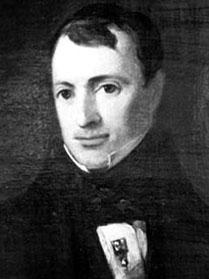- Home
- Archival Material
- College History Projects
- Subject-Based Digital Projects
John Bannister Gibson (1780-1853)

John Gibson was born on November 8, 1780 at what is now Gibson’s Mill, in the Shearman’s Valley of Perry County, Pennsylvania. His father, Colonel George Gibson, was one of the 637 killed at the defeat of Major General Arthur St. Clair on the Wabash in Indiana at the hands of the Miami Indians on November 4, 1791. His widow, Anne West Gibson, was left to farm and care for their young children, of whom John was the youngest. John Gibson entered Dickinson Grammar School in Carlisle, Pennsylvania in 1795, and joined the College proper with the Class of 1798. Before he graduated, however, he left to study law under Judge Thomas Duncan in Carlisle and was admitted to the Bar of Cumberland County on March 8, 1803.
Gibson practiced law briefly in Carlisle, before moving first to Beaver, Pennsylvania and then to Hagerstown, Maryland. After a few unsatisfactory years in Maryland, he returned to his house on East High Street in Carlisle and remained a residsent for the rest of his life, and resumed his law practice. In 1810 he was elected to the Pennsylvania House of Representatives, serving two terms. On July 16, 1813, he was appointed president judge of the 11th Judicial District. For the next three years, Gibson worked in the Court of Common Pleas of Tioga, Bradford, Susquehanna, and Luzerne Counties.
On June 27, 1816, he became an associate justice of the Pennsylvania Supreme Court serving with his mentor Thomas Duncan. Ten years later the court was expanded to five justices, and in 1827, Gibson was chosen as chief justice of Pennsylvania to succeed Chief Justice Tilghman. He resigned in 1838, in response to a new State Constitution that required term limits for judicial offices. The following year he was reappointed to his old position under the new system. Also in 1839, Gibson received honorary doctor of laws degree from both the University of Pennsylvania and Cambridge. President Jackson had signaled his intent to name him to the United States Supreme Court but politics intervened and another was named. In 1850, another revision to the Pennsylvania constitution called for all Supreme Court justices to be elected to fifteen year terms, with one justice retiring every three years. Gibson opposed this new system, but was nominated in 1851 and elected to his usual post. The five justices drew lots to determine their terms of office, between three to fifteen years to accommodate the retirement law. Gibson drew a nine year appointment. He also served as a member of the board of trustees of Dickinson College between 1816 and 1829.
He had married Sarah Galbraith of Cumberland County and the couple had eight children, five of whom reached maturity. John Bannister Gibson died on May 3, 1853 in Philadelphia.
Date of Post:
2005
College Relationship:
Alumnus/Alumna Class Year:
Trustee - Years of Service:
1816-1829